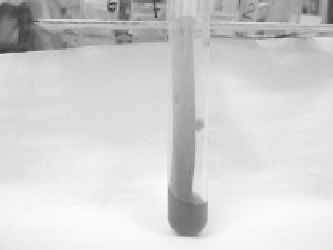Environmental Engineering Reference
In-Depth Information
FIGURE 2.24
Photograph of a PNIPAM hydrogel loaded with the chelating agent phenanthroline immersed in a dilute
(1 mM) solution of Fe
2+
ions. Note the lower color intensity at the top of the gel due to the slow diffusion of the
ion along the gel.
TABLE 2.4
Partition Coeficient of a Chelating Compound
and Its Complex with Fe
2+
Ions
Compound Partition Coeficient
1,10-Phenanthroline (Phen) 59.3
Fe Phe( )
2+
35.7
a
a
Calculated per molecule of phenanthroline.
hydrophilic effect of the Fe
2+
cation affect the partition coeficient. A possible way to
increase the partition coeficient for the complex ion imply the incorporation of nega-
tively charged groups (e.g.,
−
−
SO
3
) inside the hydrogel, to introduce coulombic interactions,
which are absent in the chelating agent. This can be easily achieved by copolymerization
of NIPAM with AMPS.
2.4.7 Use of Drug Delivery from Hydrogels in Aquaculture
Modern aquaculture uses different pharmaceuticals, including anesthetic and chemother-
apeutic agents [173]. The preferred way to deliver drugs to aquaculture organisms is oral
or dermal intake because other ways, such as injection or topical application, are imprac-
tical [174]. However, the drug has to survive the enzymes in the gut and/or be delivered
through membranes [175]. Moreover, targeted nanodelivery vehicles can avoid leakage
of drugs into the environment. Nanoporous materials could be used to deliver drugs in
water [170]. A water-soluble drug absorbed inside a polymer hydrogel or adsorbed on the
surface of a nanoporous carbon will be released into the solution by diffusion. While con-
centration gradient controlled release is useful for maintaining a constant level of drug in
the organism over time [176,177], there are alternative delivery mechanisms such as tem-
perature- or pH-driven release [178-180]. Figure 2.25 shows the concentration-time proile
of a dye
Ru bp( )
2
( )
released from a PNIPAM hydrogel into the surrounding solution.
While spontaneous release of a drug allows one to maintain a nearly constant level of the
substance in water, unlike sudden dissolution of a solid or liquid sample, a more interest-
ing approach involves the control of the drug release using external actions. Figure 2.26
shows the change of concentration of a probe dye in water due to the volume collapse of the

